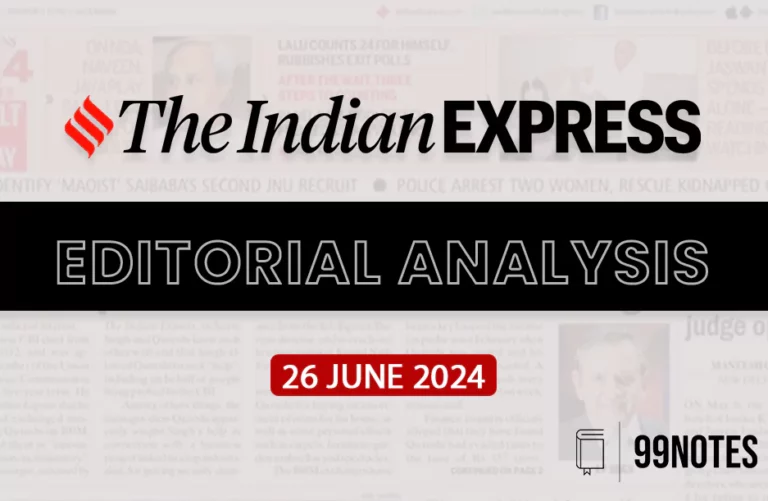18 Jan 2024 : Indian Express Editorial Analysis
Indian Express
18- January-2024
1. CUES FOR REFORM
| Topic: GS2 – Social Justice – Education This topic is relevant for both Prelims and Mains in the context of educational challenges faced by adolescents in rural India. |
| Context: |
|
Enrollment Not an End in Itself:
- Although there has been an increase in enrollment, ASER 2023 goes beyond simple statistics to draw attention to deficiencies and difficulties in fundamental competencies.
- Many students who were polled reported having difficulty with basic maths and reading comprehension, which highlights the significance of receiving a high-quality education even after enrollment.
Challenges in Foundational Skills:
- According to the report, there is a significant deficiency in fundamental skills, as evidenced by the fact that 25% of students struggle to read a text appropriate for Grade 2 and over 50% struggle with arithmetic skills required for Grade 5.
- The quality of the labour force in the nation is at risk due to this deficit, which emphasises how critical it is to address these problems in addition to skill-building initiatives.
Academic Pressures and Rural Smartphone Use:
- ASER 2023 explores the mounting academic constraints that young people are under, highlighting the fact that this problem is not limited to metropolitan settings.
- Some students deal with dual obligations, balancing schoolwork with jobs like labouring on family farms.
- The report emphasises the opportunity provided by the extensive usage of smartphones in rural regions and recommends changes to pedagogical practices to lessen such constraints.
Opportunities and Challenges of Smartphone Use:
- Despite the fact that almost 95% of rural households surveyed had smartphones, ASER sees this as a chance to expand education.
- According to the report, digital tools and flexible learning environments can support the 2020 National Education Policy (NEP).
- It does, however, highlight the necessity of encouraging parents and students to use smartphones for learning rather than just for amusement.
Vocational Education Challenges:
- Just 6% of the youngsters polled for the ASER research are now enrolled in vocational courses, indicating a major deficit in vocational education.
- In keeping with the goals set forth in NEP 2020, the report advocates for a reimagining of vocational education in India, drawing a comparison with China’s success in realising its demographic dividend through technical and vocational education reforms.
Conclusion:
- ASER 2023 offers a thorough overview of the rural Indian education system, highlighting the need for a comprehensive strategy that goes beyond enrolment figures, addressing deficiencies in fundamental skills, utilising technology, and rethinking vocational education to realise the demographic dividend.
| PYQ: Discuss the main objectives of Population Education and point out the measures to achieve them in India in detail. (250 words/15m) (UPSC CSE (M) GS-1 2021) |
| Practice Question: Discuss the key findings of the Annual Status of Education Report (ASER) 2023, focusing on the challenges and opportunities revealed in the education landscape for 14-18-year-olds in rural India. (200 words/12.5 m) |
2. CLASSROOM AT A CLICK
| Topic: GS2 – Social Justice – Education This topic is relevant for both Prelims and Mains. For Prelims: ASER 2023 survey data, and technology advancements For Mains: various dimensions of education, technology, societal changes, and environmental education |
| Context: |
|
Smartphone Usage Patterns:
- Ninety-two percent of children surveyed in the ASER 2023 survey can use a smartphone, and in the week prior to the survey, two-thirds of the youth utilised their mobile phones for academic purposes.
- The majority of educational items are exam preparation-focused, and the research does point out that smartphone usage for education is lower than for enjoyment.
Barriers to Knowledge Transfer:
- Although technology has made knowledge more accessible, the article contends that certification and knowledge transfer are still limited procedures.
- The necessity of opening up these procedures to conform to the notion of education anytime, anyplace is emphasised.
Challenges in Achieving Learning Goals:
- Although India has achieved universal enrollment in elementary schools, the ASER 2023 report highlights that enrollment is not a guarantee of learning.
- Furthermore, after finishing Class X, half of the teenagers begin working part-time, highlighting the necessity for formal education procedures to be flexible in order to accommodate working pupils.
Role of Open Schooling and Digital Technology:
- The article supports fast advancing technology in conjunction with the decentralisation and reinforcement of open school and open university procedures.
- It imagines a period when digital technology will enable teaching, learning, and testing to occur anywhere, at any time.
Diverse Education Needs and Opportunities:
- More universities are required in India due to the country’s rising population, but non-formal education is also necessary to meet a variety of demands.
- There are advantages and disadvantages to the widespread use of smartphones and cheap data.
- According to the article, digital technology may bridge knowledge gaps, particularly in areas like agriculture where formal education may not provide enough coverage.
Importance of Environmental Education:
- The article highlights the need for a mental shift and makes the case that education should go beyond strict frameworks to include topics like agriculture and environmental challenges.
- It emphasises how environment, climate, and natural resource management are interconnected and how important it is for everyone to be knowledgeable about these topics.
- Changing Education Goals and Mindsets:
- The article’s conclusion acknowledges how education’s objectives are evolving and how there is a growing emphasis on life goals in addition to academic ones.
- It implies that although technology can help, mentality shifts are necessary for the educational system to advance and accommodate a range of goals.
Conclusion:
- The article talks on the development of educational technology, difficulties in meeting learning objectives, the opportunities that come with smartphones, and the need for a more adaptable and inclusive educational system that takes changing priorities and aspirations into account.
| PYQ: How have digital initiatives in India contributed to the functioning of the educational system in the country? Elaborate your answer. (250 words/15m) (UPSC CSE (M) GS-1 2020) |
| Practice Question: Examine the need for reforms in the education system to align with changing aspirations and the adoption of digital technologies. (200 words/12.5 m) |
For Enquiry

13 Feb 2024 : Daily Current Affairs Quiz

13 Feb 2024 : Daily Answer Writing

13 Feb 2024 : Daily Current Affairs

13 February 2024 : The Hindu Editorial Notes PD

13 Feb 2024 : Indian Express Editorial Analysis

13 February 2024 : PIB Summary for UPSC

12 Feb 2024 : Daily Current Affairs Quiz

12 Feb 2024 : Daily Answer Writing

12 Feb 2024 : Daily Current Affairs

12 Feb 2024 : Indian Express Editorial Analysis
Daily Quiz 13 Feb 2024 : Daily Current Affairs Quiz 13 Feb 2024 : Daily Quiz…
mains answer writing 13 Feb 2024 : Daily Answer Writing Mains Answer Writing
13-February-2024
Q1) With the help of a map, show major ocean currents of the world….
Daily Current Affairs 13 Feb 2024 : Daily Current Affairs Daily Current Affairs
13-February-2024- Top News of the Day
1. Indian Navy Personnel Released from Custody…
Feb 2024 The Hindu 13 February 2024 : The Hindu Editorial Notes PD The Hindu Editorial
13-February-2024
1. A global alliance to bridge the gender equity gap
Topic:…
Indian Express 13 Feb 2024 : Indian Express Editorial Analysis Indian Express Editorial Analysis
13-February-2024
1. A science for us
Topic: GS2 – Governance…
feb 2024 PIB 13 February 2024 : PIB Summary for UPSC PIB Summary for UPSC
13-February -2024
1. Union Minister G Kishan Reddy inaugurate regional centre…
Daily Quiz 12 Feb 2024 : Daily Current Affairs Quiz 12 Feb 2024 : Daily Quiz…
mains answer writing 12 Feb 2024 : Daily Answer Writing Mains Answer Writing
12-February-2024
Q1) “Water scarcity threatens economic and social gains…
Daily Current Affairs 12 Feb 2024 : Daily Current Affairs Daily Current Affairs
12-February-2024- Top News of the Day
1. Great Indian Bustards give Nandyal a…
Indian Express 12 Feb 2024 : Indian Express Editorial Analysis Indian Express Editorial Analysis
12-February-2024
1. CLASSROOM VS COACHING
Topic: GS2 – Social…


